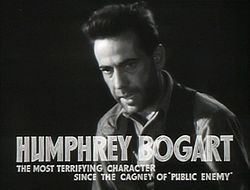The Godfather pioneering Italian-American Mafia films
In 1972, Francis Ford Coppola's The Godfather was released. The epic story of the Corleone family, its generational transition from post-prohibition to post-war, its fratricidal intrigues, and its tapestry of mid-century America's criminal underworld became a huge critical and commercial success. It accounted for nearly 10% of gross proceeds for all films for 1972. [12] It won the Oscar for Best Picture, as well as the award for Best Actor for Marlon Brando [13] and is widely considered one of the greatest American films of all time. In 1974, The Godfather Part II became the fifth-highest-grossing film of the year and garnered 11 Academy Award nominations. It again won Best Picture. Coppola won Best Director and Robert De Niro won best supporting actor for his portrayal of a young Vito Corleone.
The lesson of the films' successes was not wasted on Hollywood. Throughout the 1970s and 1980s, the studios issued a steady flow of films about Italian American gangsters and the Mafia. Some of these were critically acclaimed. Scorsese's Goodfellas about Henry Hill's life and relationship with the Lucchese and Gambino crime families, was nominated for six Academy Awards, including Best Picture and Best Director and won the award for Best Supporting Actor for Joe Pesci's performance. Italian-American film Once Upon a Time in America directed by Sergio Leone about David "Noodles" Aaronson played by Robert De Niro is considered one of the best gangster films of all time. [14]
The 1987 film The Untouchables was nominated for four Academy Awards. Sean Connery won the Academy Award for Best Supporting Actor in his role as an associate of Eliot Ness who helped bring down Al Capone. [15] Others, however, strayed into stereotypes and the gratuitous use of Italian ethnicity in minor characters who happened to be criminals. This created a backlash in a portion of the Italian American community. [16]
Scorsese and the 1990s–2010s
In the 1990s there were several critically acclaimed mob films, many of which were loosely based on real crimes and their perpetrators. Many of these films featured long-time actors, well known for their roles as mobsters such as Al Pacino, Robert De Niro, Joe Pesci and Chazz Palminteri.
In 1990, Goodfellas , directed by Martin Scorsese, starred Ray Liotta as real-life associate of the Lucchese crime family Henry Hill. It was one of the most notable gangster films of the 1990s. Robert De Niro and Joe Pesci also starred in the film, with Pesci earning an Academy Award for Best Actor in a Supporting Role. The film was nominated for six Academy Awards, including Best Picture and Best Director, making Goodfellas one of the most critically acclaimed crime films of all time.
In 1990, The Godfather Part III was released. Al Pacino reprised his role as the iconic Michael Corleone. The film served as the final installment in The Godfather trilogy, following Michael Corleone as he tries to legitimize the Corleone family in the twilight of his career.
In 1993, Pacino starred in Carlito's Way as a former gangster released from prison who vows to go straight.
In 1995, following their collaboration in Goodfellas, Scorsese, De Niro and Pesci teamed up again to make Casino , based on Frank Rosenthal, an associate of the Chicago Outfit, that ran multiple casinos in Las Vegas during the 1970s and 1980s. The film was De Niro's third mob film of the 1990s, following Goodfellas (1990) and A Bronx Tale (1993).
In 1996, Armand Assante starred in the television film Gotti as infamous New York mobster, John Gotti.
In 1997's Donnie Brasco , Pacino starred alongside Johnny Depp in the true story of undercover FBI agent Joseph Pistone and his infiltration of the Bonanno crime family of New York City during the 1970s. It was nominated for an Academy Award for Best Adapted Screenplay.
In 2006, Scorsese released The Departed , his adaptation of Infernal affairs , the Hong Kong film. The Departed was also loosely based on the Whitey Bulger story, and Boston's Winter Hill Gang, which Bulger led. It earned Scorsese an Academy Award for Best Director, and won the Academy Award for Best Picture.
A 2018 biographical mafia film, Gotti , directed by Kevin Connolly, stars John Travolta as John Gotti, released in June. On review aggregator Rotten Tomatoes, the film holds an approval rating of 0% based on 38 reviews, and an average rating of 2.3/10. The website's critical consensus reads, "Fuhgeddaboudit." [17] In 2019, Martin Scorsese released a biographical mafia film distributed by Netflix, The Irishman , starring all three heavyweights in the genre, Robert De Niro as Frank "The Irishman" Sheeran, Al Pacino as Jimmy Hoffa and Joe Pesci as Russell Bufalino. [18]



